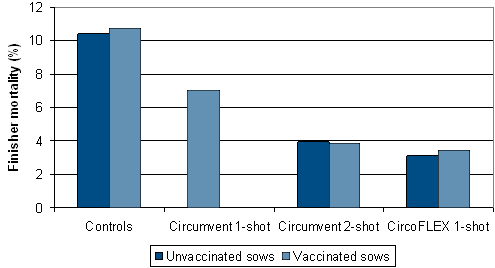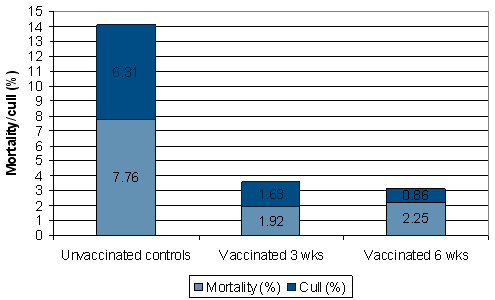In a recent Canadian report, where there was late onset PCV2-associated mortality at between 17-21 weeks of age (Cardinal, 2008) the mortality was 10.4% in the unvaccinated control progeny and 10.7% in the pigs from the sows vaccinated with Circovac® (Merial) (see Table 1), so there was no noticeable effect at that stage.
Table 1. Comparison finisher mortality (%) after sow and piglet vaccine use in Canada
| No sow vaccine | Sow vaccine given | |
| Controls | 10.4 | 10.7 |
| Circumvent (1 shot) | 7.0 | - |
| Circumvent (2 shots) | 3.9 | 3.8* |
| CircoFLEX (1 shot) | 3.1 | 3.4* |
In contrast, piglets vaccinated with a 1-shot or 2-shot with Circumvent® PCV (Intervet / S-P) at 3 and 7 weeks of age or 1-shot with Ingelvac CircoFLEX® (Boehringer Ingelheim) had a mortality rate of 7.0, 3.9 and 3.1% respectively, in comparison with the pigs from unvaccinated sows. When piglets were also vaccinated with Circumvent 2-shot and CircoFLEX 1-shot from vaccinated sows the mortality again was reduced to 3.8 and 3.4%, respectively. Maternally derived antibodies did not appear to interfere with the vaccines.
Figure 2. Overall finisher mortality results following sow and piglet vaccination

The age of piglet vaccination does not appear to be too critical as long as it is at least two weeks before the PCV2 viraemia starts, to enable the pig’s immune system to develop resistance before the challenge.
In a US study Cline and others (2008) vaccinated pigs at 3 or 6 weeks of age with CircoFLEX and compared them with unvaccinated controls. The farm operated a 3-site production system and the pigs were weaned at 3 weeks of age into nurseries and moved at 10 weeks of age into the finisher barns and kept there until slaughter. The farm was free of PRRSV and Mycoplasma hyopneumoniae but had been suffering from PCV2 losses in the finishing pigs for several months.
The mortality in the nurseries was similar for all three groups, associated with non PCV2 infections such as Streptococcus suis and Haemophilus parasuis. Classical signs of wasting disease and mortality started in the finishing barns in the unvaccinated pigs at about 11 weeks of age (see Table 2). This coincided with a dramatic increase in PCV2 viraemia observed in the unvaccinated pigs.
Table 2. Mortality, cull rate and end weight at finishing in vaccinated pigs and unvaccinated controls
| Vaccinated 3 weeks | Vaccinated 6 weeks | Unvaccinated controls | |
| Cull* rate (%) | 1.68** | 0.86** | 6.31 |
| Mortality rate (%) | 1.92** | 2.25** | 7.76 |
| Cull rate + mortality rate (%) | 3,60 | 3,11 | 14,07 |
| Weight (kg) | 115.0** | 115.2** | 109.0 |
The finisher mortality rate was reduced in both the 3 and 6 week vaccinated groups by 5.84% and 5.51%, respectively. The number of cull pigs (pigs which were below 82kg at barn close out) was reduced by 4.63 and 5.45% (see Figure 3). These smaller pigs are severely downgraded and penalized in the US and fetch only 44% of the value/kg of the normal slaughter pig. The average finishing liveweight of the 3 and 6 week vaccinated pigs over the controls was 6.0 and 6.2kg higher, respectively.
Figure 3. Comparison of mortality and cull rates between unvaccinated controls and 3 or 6 week old vaccinated pigs (wasting started at 11weeks of age)

Overall, there was little difference between the two vaccination protocols. Natural maternally derived antibodies did not appear to interfere with the 3-week vaccinated group and gave protection throughout the growing period and there was enough time for immunity to develop in the 6-week vaccinated pigs before the viraemia started to develop, when the pigs were moved into the finishing barns at 10 weeks of age.
The economic analysis of the trial (based on: - FCE 2.5; liveweight value $1.10/kg; cull weight value $0.48/kg; feed cost $176/tonne) showed the cost/benefit for the vaccinated pigs to be an amazing $9.85/pig produced, compared to the unvaccinated controls.
The key to managing PCV2-associated mortality in finisher pigs seems to be to identify the age the mortality starts and target vaccination to make sure the piglets are protected at least 3-4 weeks before infection takes off. Earlier vaccination, as young as 2 weeks of age or at weaning also gives protection throughout the nursery period as well. Vaccination appears to be very cost effective and approximately, a 1% saving in mortality pays for the vaccine.




